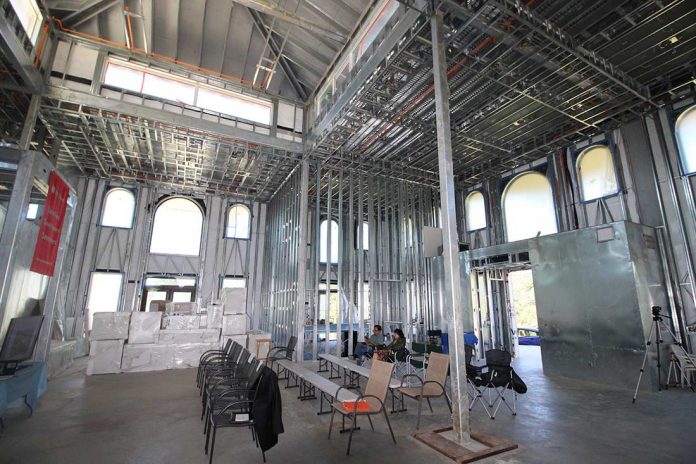
In 2018, California suffered its most destructive fire season in history, with nearly 1.9 million acres burned. The Camp Fire in Butte County, which burned in November, scorched more than 18,000 buildings and killed 85 people.
With wildfires becoming deadlier every year, a Morgan Hill-based startup company is hoping home builders across the state will do away with combustible wood structures and embrace non-flammable steel frames. Firefighting experts say an increase in steel residential construction could show some promise in reducing potential damage, death and injury from wildfires in the future.
Yuhu Builders Corporation unveiled its prototype home under construction on Armsby Lane in Morgan Hill June 6 during a presentation that drew city and fire officials, architects, insurance agents and others.
The 6,000-square-foot home located on a hillside is custom designed and constructed using light gauge steel frames, which are pre-fabricated at a factory and assembled on site, said Eugene Yu, founder and president of Yuhu Builders.
A steel-framed home is not only fire-resistant, Yu said, but earthquake-resistant, termite-proof and mold-proof. The exterior of the prototype home consists of wall panels manufactured by Hebel Metal, which are layered with aerated concrete that can withstand fire for up to four hours, according to the German manufacturer.
“We have hosted visitors at our prototype site every week for the last six months, and they all prove the same point: Seeing is believing,” said Rick Pearce, vice president of operations at Yuhu Builders. “By using our prototype home as an example, our intention is to give a firsthand view of the materials, processes and technologies that will soon transform the way homes are built in California.”
But getting the wood-dominated industry to catch on will prove to be a challenge, Yu said.
While steel frames are common in commercial construction, they have not taken off in the residential sector, he said, primarily due to costs.
While Yu declined to give an estimate of how much the steel home costs per square foot compared to a traditional wood construction, he said he was confident that the cost of future installations would be equivalent to if not cheaper than wood, as the one-time research and development costs were expensive for the prototype home.
Morgan Hill Fire Marshal Dwight Good said that while he was still learning about the techniques used to construct the home, he noted that it is a good start in preventing the spread of wildfire.
“This is encouraging,” he said. “Having fire-resistant construction and techniques is critical in a place like this.”
Mayor Rich Constantine, a retired San Jose firefighter, said he was impressed by the home, and added that such a structure could be used as a refuge for firefighters during major wildfires.
“If this was implemented throughout the industry, it could not only save property, it could help save lives as well,” he said.
With the weather beginning to heat up, fire season is underway across the state.
“We’re bracing for as bad or worse than what we saw last year,” Good said at the June 6 press conference.
Later in the week, on June 9, fire agencies battled their first significant wildfire in Santa Clara County—the 210-acre Malech Fire on Malech Road north of Morgan Hill. As of June 10, that fire was more than 85 percent contained.
Good said a fire-resistant home is only half the battle when preparing for wildfire.
“Landscape design and maintenance is so critical,” Good said.
Cal Fire advises residents to create “defensible space” around their homes by doing the following:
Within 30 feet from structures:
• Remove all dead or dying vegetation.
• Trim tree canopies regularly to keep branches a minimum of 10 feet from structures and other trees.
• Remove leaf litter (dry leaves/pine needles) from yard, roof and rain gutters.
• Relocate woodpiles or other combustible materials to areas 30 to 100 feet away.
• Remove combustible material and vegetation from around and under decks.
• Remove or prune vegetation near windows.
• Remove “ladder fuels” (low-level vegetation that allows the fire to spread from the ground to the tree canopy). Create a separation between low-level vegetation and non-vegetative materials such as patio furniture, wood piles, swing set, etc., from tree branches. This can be done by reducing the height of low-level vegetation and/or trimming low tree branches.
Within 30 to 100 feet of structures:
• Remove “ladder fuels.”
• Cut or mow annual grass down to a maximum height of four inches.
• Trim tree canopies regularly to keep their branches a minimum of 10 feet from other trees.
• Loose surface litter, normally consisting of fallen leaves or needles, twigs, bark, cones and small branches, shall be permitted to a depth of three inches if erosion control is an issue.
For information, visit readyforwildfire.org.







